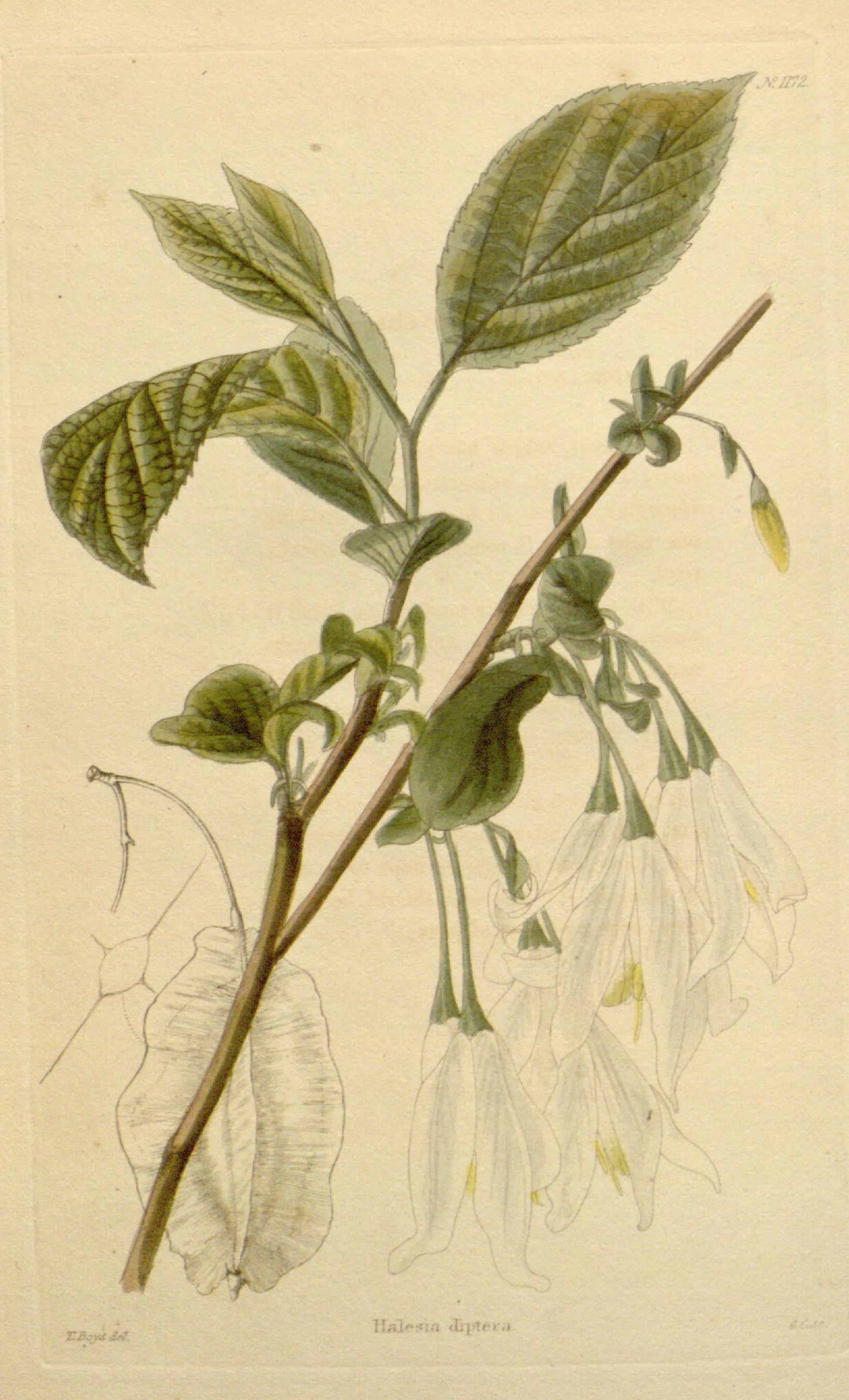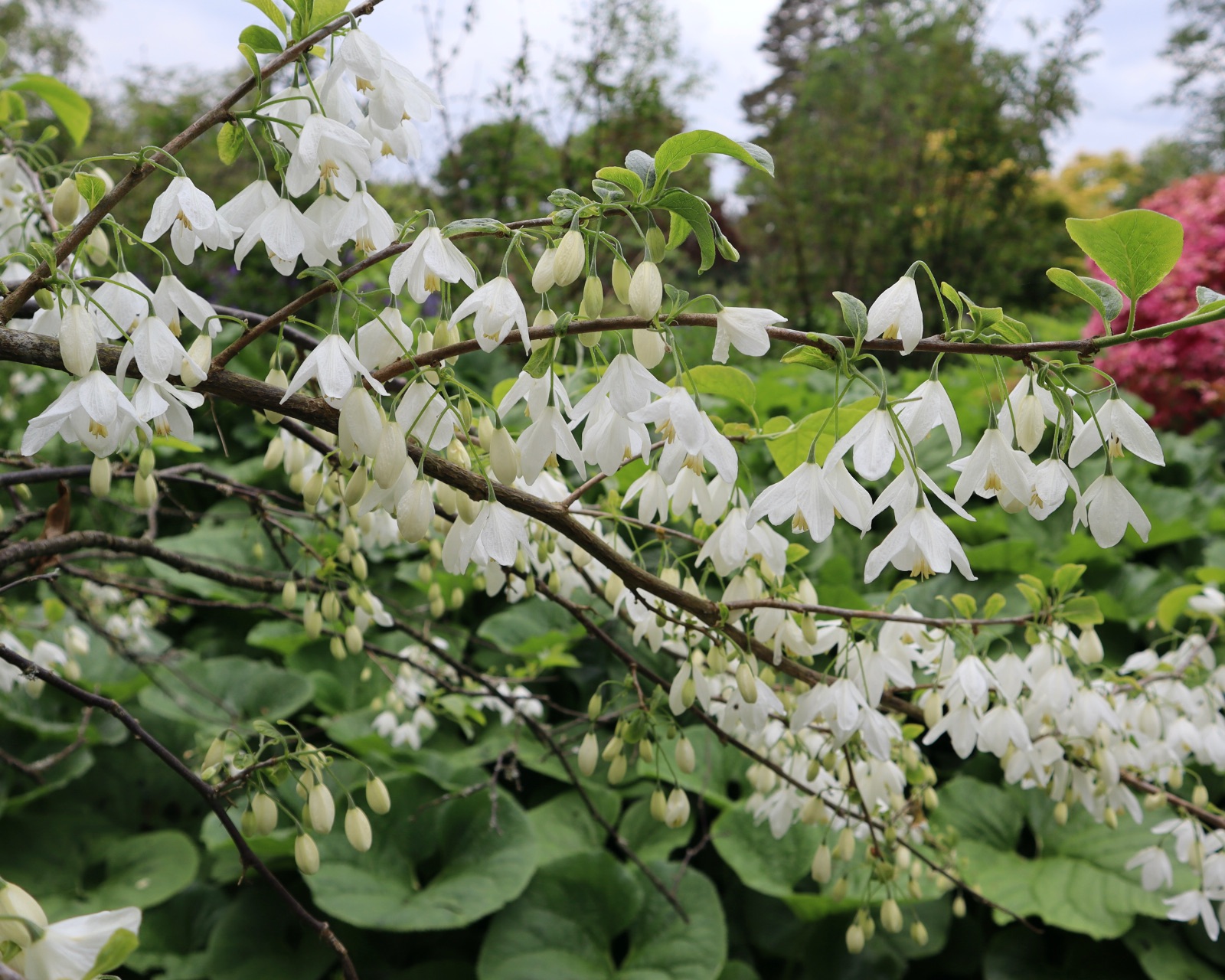Halesia diptera
Sponsor
Kindly sponsored by
Arabella Lennox-Boyd
Credits
Alan Elliott & Tom Christian (2018)
Recommended citation
Elliott, A. & Christian, T. (2018), 'Halesia diptera' from the website Trees and Shrubs Online (treesandshrubsonline.
Genus
Common Names
- Two-winged silverbell
- Snowdrop tree
Synonyms
- Halesia diptera var. magniflora R.K. Godfrey
Shrubs or trees to 11 m. Leaves 8.1–17 × 5.5–12 cm, ovate, elliptic, or obovate, adaxially glabrous, abaxial with soft downy indumentum, margins serrate 12–26-toothed; petiole 1.5–3.5 cm. Inflorescences short raceme, or appearing fasciculate if small, 2–6-flowered, occasionally solitary, usually bracteolate. Flowers, pendulous, campanulate; calyx 4–8 × 2–5.5 mm, hairy; corolla 13–31mm, hairy, fused portion to 1 mm, lobes 13–31 × 5–15 mm, stamens 7–10, 13–25 mm; filaments adnate to corolla to 1 mm, free portion connate 2.5–11 mm, distinct portion 4–12 mm, pubescent adaxially and usually abaxially; anthers 4–5 mm; style hairy. Fruit drupe 2– or 4-winged (if 4-winged, 2 broad wings alternate with 2 narrower wings), narrowly oblong to broadly ellipsoid or slightly clavate, 3.5–6 × 1.2–2.6 cm. (Fritsch 2009).
Distribution United States Alabama, Arkansas, Florida, Georgia, Louisiana, Mississippi, South Carolina, Texas
Habitat Wooded floodplains, stream banks, swamps edges, roadsides, between 0 and 100 m asl.
USDA Hardiness Zone 7b-8a
RHS Hardiness Rating H4
Conservation status Not evaluated (NE)
Taxonomic note This species can also be readily be distinguished from H. carolina in fruit. This species has two large wings (hence “diptera”) and two that are reduced to almost ridges, compared to H. carolina which has 4-winged fruit, with all wings of approximately equal size. A large flowered form with flowers to c. 3 cm, from the eastern edge of the species’s range and previously known as var. magniflora, is reduced to a synonym of the type (Fritsch 2009). In cultivation large flowered forms are recognised as a cultivar group, the Magniflora Group.
Although this species does not appear to flower as profusely as some forms of Halesia carolina it is worthy of being more widely cultivated. Like many in the Styrax family it has interest throughout the year with bright white flowers in spring, yellow autumnal foliage and 2-winged fruits that remain on the trees over winter.
This species is cited as being able to withstand temeratures down –15°C, but it does not appear to be in cultivation in major collections the north of England or Scotland suggesting that it may not be as hardy as suggested, or that in order to be winter hardy, an amount of summer heat is necessary to ripen the wood. It is in collections in the the milder south of the UK, at Caerhays, Cambridge University Botanic Garden, RBG-Kew and the Sir Harold Hillier Gardens (Tree Register 2018). This species is more widely cultivated in the US and easier to find in the nursery trade there.
Based on this species’ native range and habitat, it would probably benefit from being planted in a woodland garden where it could enjoy the shelter of larger trees and shrubs, or in a sheltered urban garden in milder parts. While not fully assessed for the IUCN across its range, at State level in Arkansas this species is considered “vulnerable” due to habitat loss and degradation.
Magniflora Group
RHS Hardiness Rating: H6
Magniflora Group forms have flowers 2–3 cm long, produced in greater profusion than is usually seen in the type. Several accounts could be misinterpreted as suggesting the flowering takes place before the leaves emerge, but it would be more accurate to say that this group begins flowering before the leaves emerge, but that flowering continues as the plants come into leaf and there can be significant overlap. Originally described as a variety, more recent treatments argue that plants belonging here are better treated as a Cultivar Group.
Darke (2006) suggests that trees can attain 10–15 m in height, and that they are proving more drought resistant in cultivation that other entities within the genus, probably on account of their habitat in nature being upland sites, bluffs and ravines in the southeastern USA. Plants of this group have been in cultivation in North America and Europe (including the UK & Ireland) for some time, and were given an Award of Merit by the RHS in 1970 (Hillier & Coombes 2002). It appears to be fully hardy, having survived temperatures as low as –18°C in the Netherlands (Scottish Rock Garden Club, online forum).


